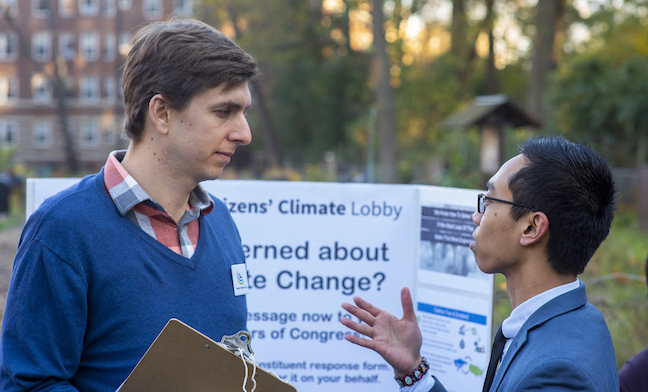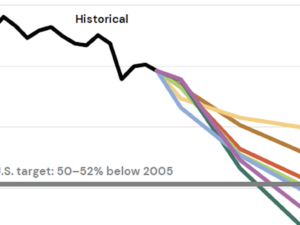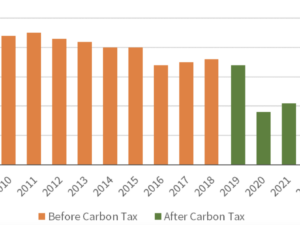Let’s dive in: Clean Electricity Standards
By Tony Sirna
As Congress and climate advocates look at how to move forward on climate this year, you may have seen stories popping up that discuss a clean electricity standard. This recent op-ed in Vox said a clean electricity standard should be “at the top of the Congress’s to-do list.” Grist has reported on the idea, and some senators, including Ed Markey and Tina Smith, are talking it up in the press.
So, what exactly is a Clean Electricity Standard (CES)? How does it work? And how does it compare to a carbon fee and dividend?
First, some general background on climate policies. Most people see policies as coming in three main flavors:
- Investments and spending, like a tax credit for installing solar panels or direct funding of research and development
- Standards and regulations, like requiring a certain level of energy efficiency in appliances, or fuel economy standards for vehicles
- Carbon pricing, which discourages greenhouse gas emissions by imposing a fee on them.
Sometimes these flavors can be swirled together. Pricing is, in some ways, a form of regulation. Or Some regulations have an accompanying fine or penalty that makes them a lot like pricing. Some prices also include spending or rebates that act as incentives. In all cases, the goal is to encourage or require the things you want more of and to discourage or forbid the things you want less of.
A closer look at Clean Electricity Standards
Clean Electricity Standards, sometimes called Renewable Portfolio Standards (RPS), have been around in various forms for a few decades, with existing policies in many states. Basically, they require that a certain portion of electricity sold by utilities come from clean energy sources by a certain date. Sounds simple, but like many policies, there are a lot of details to consider and they make a big difference.
What counts as clean energy?
A big question is: what is considered “clean energy” under a CES? Is it just renewable energy like solar and wind, or does the policy treat big hydroelectric power, nuclear, biomass, or fossil fuel-based power with carbon capture as “clean” options too? Are there partial credits for cleaner energy, which would incentivize gas over coal? In some cases, there are additional requirements for solar and wind, or even specific types of systems like rooftop solar.
What does a Clean Electricity Standard cover?
Another question is how broadly the policy applies. In some cases, only investor-owned utilities are covered, with no requirements for municipal utilities and rural electric co-ops. Others waive the requirements for small-scale providers.
How does a Clean Electricity Standard actually work?
CES policies generally allow some sort of trading of credits between utilities. For instance, If two utilities are both required to sell 50% clean energy and one has produced 60% clean energy and another 40%, the latter could buy credits from the former and be in compliance with the law. This effectively ends up much like cap-and-trade systems, with further complexities around who can trade with whom, how long you can bank credits, etc.
In some systems, there is also an “alternative compliance” option that essentially allows for purchasing clean energy credits from the government, which effectively sets a maximum price for such credits on any trading market. In the end, such a system can end up quite similar to a carbon pricing system.
These details can get pretty arcane, but they do matter. Partial credits for natural gas could mean coal is phased out sooner, but might lock in more gas-powered infrastructure. How methane leakage and other upstream emissions are factored in can also affect usage of natural gas. Either of these details may affect nuclear plants’ viability. Interim targets can be as important as the final targets that get more media attention—100% clean electricity by 2035, for example.
How does CES compare to a carbon tax?
If you’re familiar with CCL’s preferred policy of a carbon fee and dividend, you may have already spotted some differences as you read the preceding paragraphs. Summed up, the key differences are:
- A CES only affects the electricity sector, which currently produces about 25% of U.S. emissions. By contrast, a carbon fee and dividend is economy-wide and covers 83% of U.S. emissions.
- If a CES is designed in a complex way with extensive bureaucracy, it can be easier for regulated entities to manipulate in ways that reduce their effectiveness. A carbon tax can be much simpler to set up and administer, with fewer entities to regulate, and fewer details to factor in.
There are some similarities, too:
- Models show that a carbon fee and dividend policy like the Energy Innovation and Carbon Dividend Act would lead to 76% clean electricity by 2030. That’s in line with some of the more aggressive national CES proposals.
- A simple CES could act much like a simple carbon price to avoid bureaucratic pitfalls.
And with either a carbon price or a CES, the question remains of what to do with any revenue. In both cases, money could go to various purposes: a dividend or other method of addressing any higher costs to consumers, investments in other programs like efficiency or research, or possibly incentives for more clean energy (perhaps a ‘feebate’ model where fees collected are rebated to those producing clean energy).
The political calculus
Beyond those policy details, members of Congress will be making political considerations on these policies, too. Polls show both policy options are popular. Despite that, some feel that it is easier to sell “clean electricity” than a “carbon price.” On the other hand, a dividend check can be a compelling selling point both in passing a policy and also in maintaining support over the long run.
And with the current close split in Congress, it’s also worth considering the legislative process. CCL volunteers are lobbying for a bipartisan carbon pricing bill that could move through normal order—getting introduced with support from both parties, being marked up in committees, and coming to a vote in both chambers before going to the president’s desk. There are other ways for climate legislation to move forward, too—namely, a process called “budget reconciliation,” which Congress will do this spring and in late summer. Any policy that affects the budget (which could include climate policies, infrastructure plans, pandemic relief, and more) can be packaged up and passed with a simple majority. Since a carbon price is very clearly related to the budget, it would be much easier to include a carbon price in the budget reconciliation process than a CES.
At the end of the day, the groups advocating for a carbon tax and for a Clean Electricity Standard share a common goal: stopping climate change and setting America up for a safe, prosperous future. We’re encouraged that there are so many ambitious proposals on the table, and we look forward to building more momentum to achieve something big in 2021.
Related Pages:






